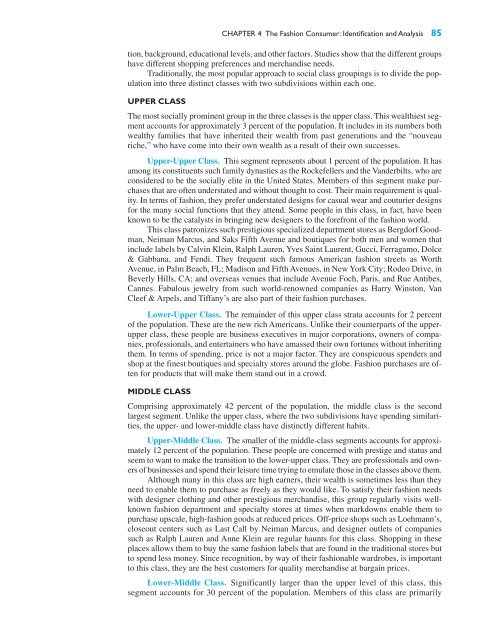Chapter 4 - Pearson
Chapter 4 - Pearson
Chapter 4 - Pearson
You also want an ePaper? Increase the reach of your titles
YUMPU automatically turns print PDFs into web optimized ePapers that Google loves.
dia76827_ch04.qxd 11/29/04 7:55 PM Page 85<br />
CHAPTER 4 The Fashion Consumer: Identification and Analysis 85<br />
tion, background, educational levels, and other factors. Studies show that the different groups<br />
have different shopping preferences and merchandise needs.<br />
Traditionally, the most popular approach to social class groupings is to divide the population<br />
into three distinct classes with two subdivisions within each one.<br />
UPPER CLASS<br />
The most socially prominent group in the three classes is the upper class. This wealthiest segment<br />
accounts for approximately 3 percent of the population. It includes in its numbers both<br />
wealthy families that have inherited their wealth from past generations and the “nouveau<br />
riche,” who have come into their own wealth as a result of their own successes.<br />
Upper-Upper Class. This segment represents about 1 percent of the population. It has<br />
among its constituents such family dynasties as the Rockefellers and the Vanderbilts, who are<br />
considered to be the socially elite in the United States. Members of this segment make purchases<br />
that are often understated and without thought to cost. Their main requirement is quality.<br />
In terms of fashion, they prefer understated designs for casual wear and couturier designs<br />
for the many social functions that they attend. Some people in this class, in fact, have been<br />
known to be the catalysts in bringing new designers to the forefront of the fashion world.<br />
This class patronizes such prestigious specialized department stores as Bergdorf Goodman,<br />
Neiman Marcus, and Saks Fifth Avenue and boutiques for both men and women that<br />
include labels by Calvin Klein, Ralph Lauren, Yves Saint Laurent, Gucci, Ferragamo, Dolce<br />
& Gabbana, and Fendi. They frequent such famous American fashion streets as Worth<br />
Avenue, in Palm Beach, FL; Madison and Fifth Avenues, in New York City; Rodeo Drive, in<br />
Beverly Hills, CA; and overseas venues that include Avenue Foch, Paris, and Rue Antibes,<br />
Cannes. Fabulous jewelry from such world-renowned companies as Harry Winston, Van<br />
Cleef & Arpels, and Tiffany’s are also part of their fashion purchases.<br />
Lower-Upper Class. The remainder of this upper class strata accounts for 2 percent<br />
of the population. These are the new rich Americans. Unlike their counterparts of the upperupper<br />
class, these people are business executives in major corporations, owners of companies,<br />
professionals, and entertainers who have amassed their own fortunes without inheriting<br />
them. In terms of spending, price is not a major factor. They are conspicuous spenders and<br />
shop at the finest boutiques and specialty stores around the globe. Fashion purchases are often<br />
for products that will make them stand out in a crowd.<br />
MIDDLE CLASS<br />
Comprising approximately 42 percent of the population, the middle class is the second<br />
largest segment. Unlike the upper class, where the two subdivisions have spending similarities,<br />
the upper- and lower-middle class have distinctly different habits.<br />
Upper-Middle Class. The smaller of the middle-class segments accounts for approximately<br />
12 percent of the population. These people are concerned with prestige and status and<br />
seem to want to make the transition to the lower-upper class. They are professionals and owners<br />
of businesses and spend their leisure time trying to emulate those in the classes above them.<br />
Although many in this class are high earners, their wealth is sometimes less than they<br />
need to enable them to purchase as freely as they would like. To satisfy their fashion needs<br />
with designer clothing and other prestigious merchandise, this group regularly visits wellknown<br />
fashion department and specialty stores at times when markdowns enable them to<br />
purchase upscale, high-fashion goods at reduced prices. Off-price shops such as Loehmann’s,<br />
closeout centers such as Last Call by Neiman Marcus, and designer outlets of companies<br />
such as Ralph Lauren and Anne Klein are regular haunts for this class. Shopping in these<br />
places allows them to buy the same fashion labels that are found in the traditional stores but<br />
to spend less money. Since recognition, by way of their fashionable wardrobes, is important<br />
to this class, they are the best customers for quality merchandise at bargain prices.<br />
Lower-Middle Class. Significantly larger than the upper level of this class, this<br />
segment accounts for 30 percent of the population. Members of this class are primarily
















